Positive Material Identification or PMI for short is the process of sorting out the composition or constituent elements of a material (typically metals). This method employs both a qualitative and quantitative approach to the evaluation of alloys. PMI is a non-destructive process that finds relevance across many industries: nuclear, power, oil and gas, and pharmaceutical to name a few.
In technical terms, PMI involves the analysis of alloy whose surface has been excited through electrical stimulation. The resulting waves of light formed from such excitation are representative of the various ele-ments present In the alloy.
A spectrometer comes in handy in making a precise and accurate measurement of the wavelengths or spectral lines. PMI is a precautionary measure put in place to prevent the breakdown of equipment as a result of poor quality. With PMI, users can ensure that all equipment in their production facilities meets exact specifications.

POSITIVE MATERIAL IDENTIFICATION METHODS
PMI equipment can be classified into types: portable (handheld), mobile, and non-portable equipment. Common examples of handheld and mobile equipment are x-ray fluorescence (XRF), laser-induced break-down spectroscopy (LIBS), and optical emission spectrometry (OES).
On the other hand, an example of non-portable equipment is laboratory OES.
Laser-Induced Breakdown Spectroscopy
LIBS can be used to reveal the characteristic composition of materials by directing a laser pulse with high energy on their surfaces. Moreover, all elements can be detected with this method. This is due to the fact that every element has a unique spectrum. Although not as portable as XRF, LIBS can be used to identify almost all types of elements. It has a wider range of applications than XRF because it can be used to sort out carbon and lighter elements.
The most accurate of them all is Laboratory OES equipment. This method can give the elemental constituent as well as the percentage composition of each element. The drawback of these instruments is that they are bulky and not subject to onsite testing.
Optical Emissions Spectrometry
In optical emission spectrometry, a metal sample is excited as a result of the spark that is generated between its surface and an electrode. The atoms (vaporize atoms) in the discharge plasma, reach a high energy state. The generated spectral lines are particularly useful in the assessment of elements.
Every element in an alloy has unique and identifiable spectral lines. In order to extract the spectral configuration (emission spectrum) of the individual element, a process called diffraction grating is employed.
X-Ray Fluorescence
In X-ray fluorescence (XRF), the excitation of a metal sample or alloy, is achieved by using a primary x-ray source.
The chemistry or the constituent elements of the materials is identified by measuring the fluorescent x-ray emitted from the sample. Every element present in the alloy has a unique fluorescent or secondary x-ray. This makes the technology worthwhile in performing an assessment test. As an added benefit, the metal samples do not require destruction in order to per-form the needed test.
X-Ray Diffraction
X-ray diffraction (XRD) is used for identifying the characteristics of material properties which include but are not limited to strain, crystal structure and crystalline size.
XRD operates basically on the Bragg’s equation principle. This method describes the reflection of a parallel x-ray beam which has been directed or focused on the crystal plane of the sample. This approach to testing relies on the wide-angle elastic scattering. It is generally ap-plicable to materials whose crystalline structures are ordered.
TYPES OF PMI EQUIPMENT
PMI is a non-destructive examination method. Three of the most common equipment used for this purpose are:
- Optical emission spectrometry (OES)
- X-ray fluorescence (XRF)
- Laser Induced Breakdown Spectroscopy (LIBS)
OES on the other hand involves the exposure of a material to an electrical spark usually in the presence of argon. In response, the material becomes excited and emits light. Just as in the case of XRF, this light is material specific, that is, each material emits light that differs in intensity and color.
To ensure that a spectrometer is providing accurate results, proper training and maintenance and calibration is required.
XRF involves the exposure of the material or sample to an x-ray. In response to this, the material produces its own secondary x-ray. The composition of a specific material determines the fluorescence or levels of x-ray it emits. The assessment result containing the elemental composition can be gotten by analyzing these secondary x-rays.
To keep a XRF readings accurate, training and equipment verification is required.
LIBS is Laser Induced Breakdown Spectroscopy which is a rapid chemical analysis technology that uses a short laser pulse to create a micro-plasma on the sample surface. LIBS is a type of OES whereas the difference is how the material is excited. The main benefit is that it is extremely fast, normally just a couple of seconds. The unit is normally handheld. And most units do not require Argon.
Similar to XRF, training and equipment verification is required to obtain accurate readings.

POSITIVE MATERIAL IDENTIFICATION LIMITATIONS
- Before a PMI test is carried out, the operator must ensure that the surface of the material to be analyzed is chemically representative of the entire material.
- The surface of the material or sample must be clean enough before testing begins.
- X-ray fluorescence, one of the positive material identification methods, cannot be used to sort out sulfur, phosphorus, and carbon. PMI cannot easily detect non-metals — and by the same token, elements that exist between metals and non-metals are difficult to assess.
- When the measuring instrument is not properly handled (jarring of the instrument) during measurement, it could affect its reading. The reason is that an integral component of the instrument called the CCD detector (spectral line analyzer) may have been affected.
WHAT IS POSITIVE MATERIAL IDENTIFICATION USED FOR?
Positive Material Identification is an important process that can help businesses improve their operations and bottom line. If you’re looking for a way to improve your business or need assistance with PMI, here are a few important applications:
- PMI comes in handy when the documentation of the material’s specifications can no longer be found.
- In the event that part of the material or alloy cannot be taken for a sample text, PMI is the best way to go.
- PMI can be used to find out if a part is part of an assembly makeup.
- PMI can be used to verify if the specifications of the material on paper is true.
- It is used to find out the exact composition of materials or metal samples that are too expensive to destroy.
- PMI ensures the materials comply with the standards set by regulatory bodies.
- PMI is a testing method that is used to avoid the potential failure of materials or products during manufacturing.



 OES MAINTENANCE & CALIBRATION:
OES MAINTENANCE & CALIBRATION: